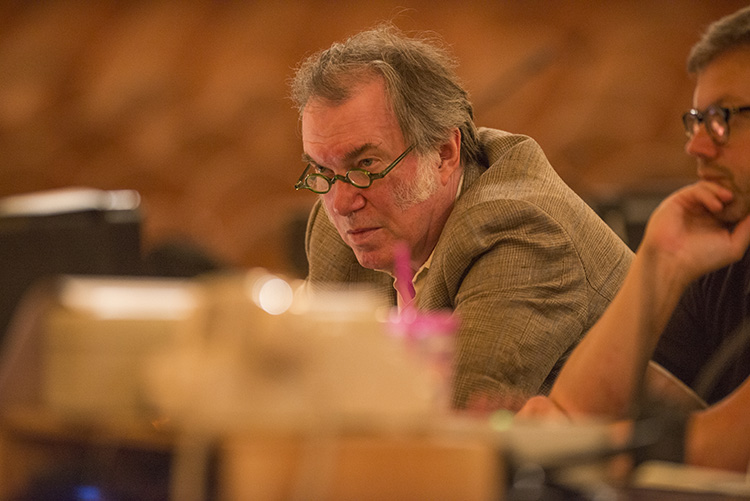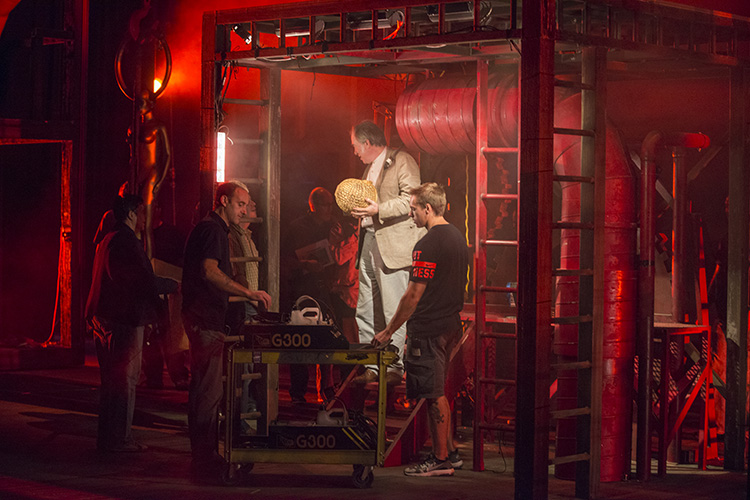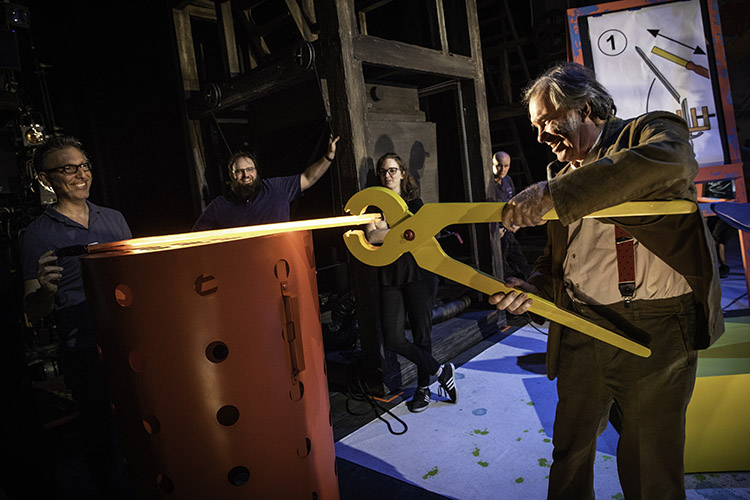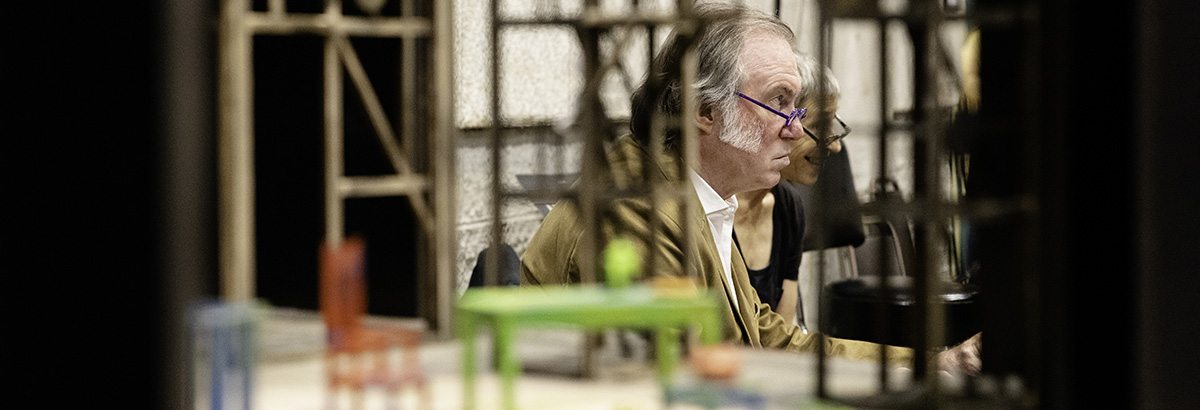April 07, 2020
Sir David Pountney on Directing the RING
Directing the Ring is a delicious opportunity for any theater practitioner. It is one of the greatest challenges in terms of technical virtuosity, interpretive acuteness, emotional truth, and musical understanding.
I would define these challenges in terms of six headings:
-
World
-
Time
-
Interpretation (Open or Closed)
-
Character (Gods or Humans?)
-
Symbolism
-
Action and effects
-
Men and women
-
Unity and disparity

The first great challenge is to define the world which is being represented on stage. Where are we? When are we? How does this story relate to our current needs and experiences as human beings? Wagner explicitly goes back to both Greek and Nordic roots in forming his cycle, understanding that the mythical and narrative worlds of Greek and Latin as well as Nordic literature reflect profound and perennial ideas of human emotional, social, and political experience. All representations of these worlds are invented – there can never be an “authentic” realization of the gods and mythic beings that inhabit the cycle. In addition to these ancient references, the politics and philosophy of Wagner’s own times pervades the Ring. Each element of these stories represents a challenge to us to find a way of representing them that connects their essential characteristics as figures in a human drama with our own particular interests and focus. Wagner was himself explicit in requiring his interpreters to make these connections anew – in his own words: “Schaff neues” – make it anew. So where and what is the “World” that we will create in which these stories will unfold here in Chicago in 2020?
For us, the world that we chose was the world of the story, and the role that we chose for ourselves as theater practitioners was the role of the storyteller. In so doing, we deliberately chose, in the face of the immense emotional, political and philosophical complexity of the Ring, to adopt a certain naivety in our stance. And we have chosen to share that naivety with you, our audience, by saying that we will always show you what we are doing and how we are doing it. In so doing, we are drawing on the ancient and immemorial and magical pact that is forged between the storyteller and the audience. Thus, when we say “This is a dragon” you agree, simultaneously, to believe that it is a dragon, even or perhaps especially when your rational being asserts that it is not a dragon at all, or perhaps even more rationally that dragons don’t exist anyway.
This directly confronts the duality of the mythic experience. In our minds we know that gods do not exist. But as profound religious experience shows, the belief in something that rationally does not exist is nonetheless overwhelmingly powerful. And when we are told stories about these gods (who do not exist) we intuitively understand that the gods nonetheless embody something profound and eternal about human experience and characteristics that tell us important things about the world around us that, perhaps unfortunately, all too apparently does exist. The storyteller therefore occupies a privileged position of trust. He invites us to believe that this is a horse, that there is a battleground, that this is a dwarf and that is a giant, and by giving the simple storyteller our suspension of disbelief, we, the audience, are permitted to enter a magical world that, however unreal, illuminates and clarifies our understanding of the necessarily mundane world in which we conduct our everyday lives. The world that we chose for our Ring is the world of “Once upon a time….” And because we are telling our story in a theater, the ambience of our story is the theater, its techniques are the simple tricks of the theater that everyone can simultaneously see through and believe in. We will not trick you with illusions and counterfeits, but instead we invite you to trick yourselves into believing in us, because you want to hear our story, and immerse yourselves in its many reflections on the way we live and interact with one another. The distance of the story brings truth closer to us all.

After the choice of the world, the next primary element for the director to master is time. At its most simple, this poses the question of when the story of the Ring takes place. Wagner himself was ambivalent about this, basing himself very explicitly in the world of the ancient Norse sagas, but nonetheless, in Rheingold, explicitly evoking contemporary 19th-century political and economic ideas, and elsewhere drawing on the 19th-century philosophical, ideas of Schopenhauer. Then there is the essential quality of time as an ingredient of this mighty drama, spread over four evenings. As a director, you forget at your peril that any smart idea you may have may make its clever point over a few minutes, but the scene is going to play on for many times that. There are certainly important moments in the Ring for sudden and surprising effects, but there are many, many more moments when time passes in the intimate exchanges between two or three characters. The Ring is a sequence of highly charged, intimate two- or three-handed chamber operas strung out along an epic time line.
We address the first element of time as an epic and mythical element by drawing out the timespan of the Ring across decades and centuries. Das Rheingold is conceived as a bucolic era in which the gods roamed freely about the world – a nomadic tribe – before they tragically immure themselves in a fortress mentality. The decay of the gods from exuberant baroque freebooting to power-obsessed political manipulators – embodied in the now-tortured character of Wotan – brings brings Die Walküre into the 1940s. Siegfried is a “growing-up story” seen from a child’s point of view and is centered in the naïve and optimistic world of the 1950s, whereas the dark and corrupt world represented in Götterdämmerung takes us forward into a dystopian future. Naturally, in an imaginative epic, none of these time frames are meant to be interpreted dogmatically, or indeed with any emphasis on period authenticity – an idea that is rarely relevant to the genre of opera. The time periods here are merely hints to the different character of each story and to the timeless ambition of the epic. The theater is a zone of imagination, not a persnickety depiction of reality.

Interpretation is the most contentious task of the director of the Ring, especially in an era in which interpretation has become significantly extreme, often reaching a level at which what is performed is a kind of simultaneous commentary on the original material rather than any kind of direct representation. The Germans, with their enduring and perhaps exaggerated respect for the intellectual, look favorably on this kind of thing, whereas the Americans, perhaps exaggeratedly suspicious of the intellectual, hate it. Our standpoint has been that confronted with the vast political and philosophical complexity of the Ring, we deliberately wish to leave the widest range of interpretations open to the audience. To my mind, a “closed” interpretation is one which isolates one or other aspect, thereby excluding others, which results in a degree of impoverishment of the richness of the cycle. If the symbolic meaning of the source of power in the Ring, the gold, is interpreted as the petro-chemical industry, for instance, this is a perfectly viable view of the story, but it is one that excludes all others, being what I call a “closed” interpretation. Our narrative process instead positions the story itself as the vital ingredient, and leaves as many possible options for the audience to create its own interpretation. Some fans of “Regietheater” (otherwise known as “Eurotrash”!) might call this an abdication of the director’s interpretive role, in which case I say, “So be it!”
A major impact of our narrative process is to place even greater emphasis on characters above ideas, and the Ring exhibits unparalleled richness in terms of individual personalities. This brings to the fore the fact that whether they are gods or not, these figures are sublimely powerful human characters. Wotan is initially a domineering, buccaneering patriarchal ruler with scant regard for the truth or the comfort of others, and yet his experience as ruler gradually reveals him to be a uniquely tortured, doubting ruler worthy of the greatest Shakespearean figures. Fasolt, the giant, may seem to be a generic fairytale being, but he reveals a touchingly emotional side. The Rhinemaidens are the aristocracy of nature, about to be wiped out by more ruthlessly materialistic beings. Fricka is simultaneously a nagging wife and a person of unbending integrity and honesty, and so on. The vividness with which director and singers realize these essentially human dimensions in all the characters goes a long way to uphold the fascination of the cycle for its audience.
As befits a mythological tale, the Ring is full of symbols, and within the overall “world” that we postulate, director and designer have to come up with visual representations of these symbols: the Rhine, the gold, the ring itself, the piling up of the gold to “obliterate” Freia, the vision of Valhalla, the rainbow bridge, the sword in the tree, the ring of fire, the forging of Nothung, the dragon, and so on. Within the chosen visual language of any version of the Ring, there are a myriad of such fantastical moments to resolve, as well as extremely challenging action sequences, like the fight between Hunding and Siegmund, and the whole final sequence of the purification of the world by fire and water. Some interpretations use elaborate technology to solve these requirements, and some Rings come to be dominated by their own stage machinery. By contrast, our solutions are simple, transparent and nakedly theatrical.
One aspect which is worth exploring is the relations across the cycle between men and women. At the start, the sybaritic innocent world of the Rhinemaidens is raped and the light of the gold put out. The epic marital quarrel between Wotan and his wife, Fricka, shows the woman to be typically if somewhat infuriatingly right. Wotan both loves his daughter, Brünhilde, but is also guilty of brutal cruelty towards her, threatening to abandon her to the predatory attentions of strange men, the ultimate betrayal of his protective role as father. It is left to Brünnhilde to find a way out for both her and her father, and at this precise moment she takes over from him as the most important character in the Ring. There is charm and delight, too, at the awkward way in which Brünnhilde and Siegfried, two young people hopelessly deprived of normal social experience by their uniquely dysfunctional upbringing, gradually grope their way towards each other, tormented by all the fears and doubts that typically accompany our initial steps in love. Rather typically, it is a woman from Valhalla, the Valkyrie Waltraute, who brings a desperate plea for help to Brünnhilde, a plea she is unable to respond to, while the useless male gods sit passively awaiting their destruction. Gutrune is a hapless young woman trapped in a very dark and corrupt family, and Siegfried is shown to be utterly unequipped to deal with the cynical manipulative power of evil. Finally, it falls to Brünnhilde to take complete charge of the climax of the cycle, initiating the purification of the world through fire and water.

To bring all this together, director and designer must engage with the unity and disparity of the four operas in the cycle. Obviously they are all part of one coherent whole, but each opera is nonetheless quite individual in character. The theatrical framework we have used to emphasize our story-teller’s approach is the framework for the whole cycle, but within that we approach the four operas quite differently, not just by advancing the time frame through the cycle. Das Rheingold is a colorful political cartoon, Die Walküre a dark and intense Ibsenesque family drama, Siegfried a child’s fairy tale of growing up, and Götterdämmerung… well, we shall see!
One of the world’s most admired and innovative opera directors, Sir David Pountney has directed six works at Lyric since the 1987/88 season: Satyagraha, Street Scene, The Passenger, Das Rheingold, Die Walküre, and Siegfried.
